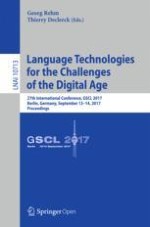
Open Access 2018 | OriginalPaper | Buchkapitel
How Social Media Text Analysis Can Inform Disaster Management
verfasst von : Sabine Gründer-Fahrer, Antje Schlaf, Sebastian Wustmann
Erschienen in: Language Technologies for the Challenges of the Digital Age
Aktivieren Sie unsere intelligente Suche, um passende Fachinhalte oder Patente zu finden.
Wählen Sie Textabschnitte aus um mit Künstlicher Intelligenz passenden Patente zu finden. powered by
Markieren Sie Textabschnitte, um KI-gestützt weitere passende Inhalte zu finden. powered by